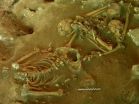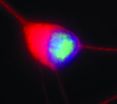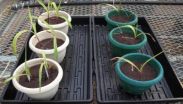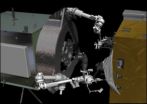(Press-News.org) In humans, a tiny area in the center of the retina called the fovea is critically important to viewing fine details. Densely packed with cone photoreceptor cells, it is used while reading, driving and gazing at objects of interest. Some animals have a similar feature in their eyes, but researchers believed that among mammals the fovea was unique to primates — until now.
University of Pennsylvania vision scientists report that dogs, too, have an area of their retina that strongly resembles the human fovea. What's more, this retinal region is susceptible to genetic blinding diseases in dogs just as it is in humans.
"It's incredible that in 2014 we can still make an anatomical discovery in a species that we've been looking at for the past 20,000 years and that, in addition, this has high clinical relevance to humans," said William Beltran, an assistant professor of ophthalmology in Penn's School of Veterinary Medicine and co-lead author of the study with Artur Cideciyan, research professor of ophthalmology in Penn's Perelman School of Medicine.
"It is absolutely exhilarating to be able to investigate this very specialized and important part of canine central vision that has such unexpectedly strong resemblance to our own retina," Cideciyan added.
Additional coauthors included Penn Vet's Karina E. Guziewicz, Simone Iwabe, Erin M. Scott, Svetlana V. Savina, Gordon Ruthel and senior author Gustavo D. Aguirre; Perelman's Malgorzata Swider, Lingli Zhang, Richard Zorger, Alexander Sumaroka and Samuel G. Jacobson; and the Penn School of Dental Medicine's Frank Stefano.
The paper was published in the journal PLOS ONE.
The word "fovea" comes from the Latin meaning "pit," owing to the fact that in humans and many other primates, the inner layers of the retina are thin in this area, while the outer layers are packed with cone photoreceptor cells. It is believed that this inner layer thinning allows the foveal cone cells privileged access to light.
It is known that dogs have what is called an area centralis, a region around the center of the retina with a relative increase in cone photoreceptor cell density. But dogs lack the pit formation that humans have, and, before this study, it was believed that the increase in cone photoreceptor cell density didn't come close to matching what is seen in primates. Prior to this study, the highest reported density in dogs was 29,000 cones per square millimeter compared to more than 100,000 cones per square millimeter seen in the human and macaque foveas.
It turns out that previous studies in dogs had missed a miniscule region of increased cell density. In this study, while examining the retina of a dog with a mutation that causes a disease akin to a form of X-linked retinal degeneration in humans, the Penn researchers noticed a thinning of the retinal layer that contains photoreceptor cells.
Zeroing in on this region, they examined retinas of normal dogs using advanced imaging techniques, including confocal scanning laser ophthalmoscopy, optical coherence tomography and two-photon microscopy. By enabling the scientists to visualize different layers of the retina, these techniques allowed them to identify a small area of peak cone density and then estimate cone numbers by counting the cells in this unique area.
Based on their observations, the researchers found that cone densities reached more than 120,000 cells per square millimeter in a never-before-described fovea-like region of the area centralis — a density on par with that of primate foveas.
"There's no real landmark for this area like there is in humans," Aguirre said, "so to discover such a density was unexpected."
They also recognized that the "output side" of this cone-dense region corresponded with an area of dense retinal ganglion cells, which transmit signals to the brain.
Human patients with macular degeneration experience a loss of photoreceptor cells — the rods and cones that process light — at or near the fovea, resulting in a devastating loss of central vision.
To see whether the fovea-like region was similarly affected in dogs, the Penn researchers used the same techniques they had employed to study normal dogs to examine animals that had mutations in two genes (BEST1 and RPGR) that can lead to macular degeneration in humans.
In both cases, the onset of disease affected the fovea-like region in dogs in a very similar way to how the diseases present in humans -- with central retinal lesions appearing earlier than lesions in the peripheral retina.
"Why the fovea is susceptible to early disease expression for certain hereditary disorders and why it is spared under other conditions is not known," Cideciyan said. "Our findings, which show the canine equivalent of a human genetic disease affecting an area of the retina that is of extreme importance to human vision, are very promising from the human point of view. They could allow for translational research by allowing us to test treatments for human foveal and macular degenerative diseases in dogs."
In addition, the discovery offers insight into a rare human condition known as fovea plana, in which people have normal visual acuity but no "pit" in their fovea. In other words, their fovea resembles that of dogs, challenging the previously held assumption that lack of tissue and blood vessels overlaying the fovea is a prerequisite for the high resolution of vision.
The fact that dogs have a fovea-like area of dense photoreceptor cells may also indicate that dogs are seeing more acutely than once suspected.
"This gives us a structural basis to support the idea that dogs might have a higher visual acuity than has been measured so far," Beltran said. "It could even be the case that some breeds have an especially high density of cells and could be used as working dogs for particular tasks that require high-level sight function."
Looking ahead, the researchers may focus on this fovea-like area in studies of therapies for not only X-linked retinal degeneration and Best disease but also other sight-related problems affecting the macula and fovea.
INFORMATION:The research was supported by the National Institutes of Health, Foundation Fighting Blindness and Macula Vision Research Foundation.
Penn team finds a new structure in dogs' eye linked to blinding retinal diseases
2014-03-06
ELSE PRESS RELEASES FROM THIS DATE:
Researchers gain new insights into ancient Pacific settlers' diet
2014-03-06
Researchers from New Zealand's University of Otago studying 3000-year-old skeletons from the oldest known cemetery in the Pacific Islands are casting new light on the diet and lives of the enigmatic Lapita people, the likely ancestors of Polynesians.
Their results—obtained from analysing stable isotope ratios of three elements in the bone collagen of 49 adults buried at the Teouma archaeological site on Vanuatu's Efate Island—suggest that its early Lapita settlers ate reef fish, marine turtles, fruit bats, free-range pigs and chickens, rather than primarily relying on ...
Atypical development in the siblings of children with autism is detectable at 12 months
2014-03-06
(SACRAMENTO, Calif.) — Atypical development can be detected as early as 12 months of age among the siblings of children with autism spectrum disorder, a study published by researchers with the UC Davis MIND Institute and UCLA has found.
Published online in the Journal of the American Academy of Child and Adolescent Psychiatry, the study found that close to half of the younger siblings of children with autism spectrum disorder (ASD) develop in an atypical fashion, with 17 percent developing ASD and another 28 percent showing delays in other areas of development or behavior. ...
Study: Alzheimer's disease a much larger cause of death than reported
2014-03-05
MINNEAPOLIS – A new study suggests that Alzheimer's disease may contribute to close to as many deaths in the United States as heart disease or cancer. The research is published in the March 5, 2014, print issue of Neurology®, the medical journal of the American Academy of Neurology.
Currently, Alzheimer's disease falls sixth on the list of leading causes of death in the United States according to the Centers for Disease Control and Prevention (CDC), whereas heart disease and cancer are numbers one and two, respectively. These numbers are based on what is reported on ...
Restless legs syndrome may signify bigger health problems
2014-03-05
(Boston)--A nationally-recognized sleep expert has published an editorial describing Restless Legs Syndrome (RLS) as a possible biomarker for underlying disease. The editorial appears in the March 5, 2014 issue of Neurology the medical journal of the American Academy of Neurology and was authored by Boston Medical Center neurologist Sanford H. Auerbach, MD.
RLS is a disorder of the nervous system. Patients with RLS have uncomfortable sensations in their legs which lead to an overwhelming urge to move them – most often at night or whenever the patient is resting.
The ...
Applying math to cancer, climate, crime and cameras
2014-03-05
Improving radiation therapies for cancer mathematically
In a paper published in December in the SIAM Journal on Scientific Computing, authors Li-Tien Cheng, Bin Dong, Chunhua Men, Xun Jia, and Steve Jiang propose a method to optimize radiation therapy treatments in cancer patients.
Radiation therapy is one of the primary methods used for cancer treatment, along with chemotherapy and surgery. While doses of radiation are delivered to eliminate cancerous tissue, care is taken to keep radiation within acceptable levels so as not to affect neighboring tissues and organs. ...
3-D changes in DNA may lead to a genetic form of Lou Gehrig's disease
2014-03-05
New findings reveal how a mutation, a change in the genetic code that causes neurodegeneration, alters the shape of DNA, making cells more vulnerable to stress and more likely to die.
The particular mutation, in the C9orf72 gene, is the most common cause for amyotrophic lateral sclerosis (ALS, also known as Lou Gehrig's disease), and frontotemporal degeneration (FTD), the second most common type of dementia in people under 65.
This research by Jiou Wang, Ph.D., and his colleagues at Johns Hopkins University (JHU) was published in Nature and was partially funded by ...
Look back at US soybeans shows genetic improvement behind increased yields
2014-03-05
URBANA, Ill. – Soybean improvement through plant breeding has been critical over the years for the success of the crop. In a new study that traces the genetic changes in varieties over the last 80 years of soybean breeding, researchers concluded that increases in yield gains and an increased rate of gains over the years are largely due to the continual release of greater-yielding cultivars by breeders.
"This research in some ways looks back and informs us how soybean varieties have changed. It's useful to document these traits and changes," said Brian Diers, a University ...
Fertility prospects following ectopic pregnancy
2014-03-05
WINSTON-SALEM, N.C. – March 5, 2014 – Preserving a fallopian tube following an ectopic pregnancy seems like it would favor a woman's fertility prospects, right?
A new study from Wake Forest Baptist Medical Center looked at pregnancy outcomes in regards to the two surgical treatments for ectopic pregnancy -- salpingectomy, in which the affected fallopian tube is removed, or salpingotomy, in which the tube is preserved.
The aim of the study, said co-author Tamer Yalcinkaya, M.D., a reproductive endocrinologist at Wake Forest Baptist, was to assess whether salpingotomy ...
Maize and bacteria: A 1-2 punch knocks copper out of stamp sand
2014-03-05
Scientists have known for years that together, bacteria and plants can remediate contaminated sites. Ramakrishna Wusirika, of Michigan Technological University, has determined that how you add bacteria to the mix can make a big difference.
He has also shed light on the biochemical pathways that allow plants and bacteria to clean up some of the worst soils on the planet while increasing their fertility.
Wusirika, an associate professor of biological sciences, first collected stamp sands near the village of Gay, in Michigan's Upper Peninsula. For decades, copper mining ...
NASA tests new robotic refueling technologies
2014-03-05
NASA has successfully concluded a remotely controlled test of new technologies that would empower future space robots to transfer hazardous oxidizer – a type of propellant – into the tanks of satellites in space today.
Concurrently on the ground, NASA is incorporating results from this test and the Robotic Refueling Mission on the International Space Station to prepare for an upcoming ground-based test of a full-sized robotic servicer system that will perform tasks on a mock satellite client.
Collectively, these efforts are part of an ongoing and aggressive technology ...



